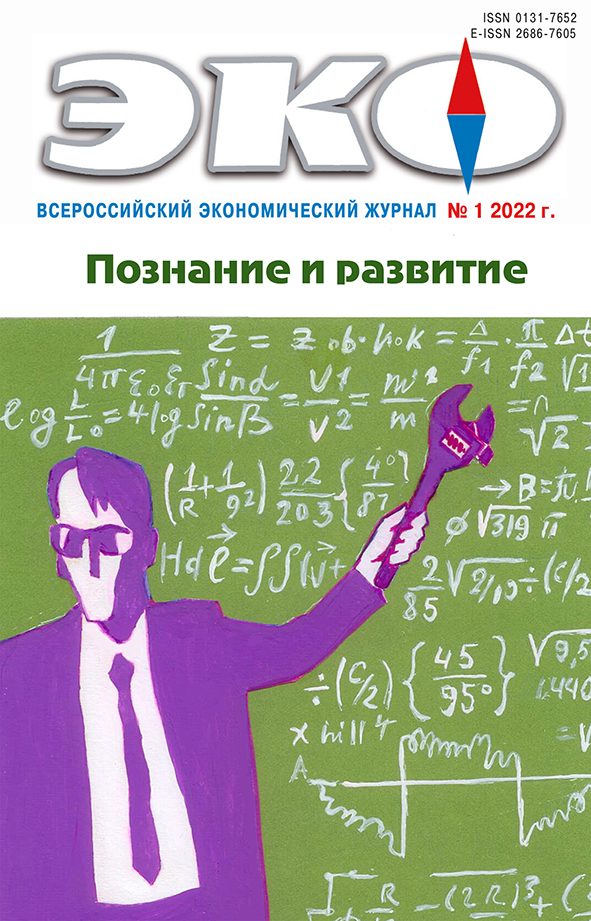DEVELOPMENT OF THE NORTH AND THE ARCTIC
Published 2021-12-29
Keywords
- Asian Russia; spatial development, resources; the concept of «big investment impulse»; investment projects; ferrous metallurgy; Kip Yenisei Syberia
How to Cite
1.
Kryukov В, Suslov Н, Yagolnitser М. The Economic Development Basis of Asian Russia. ECO [Internet]. 2021 Dec. 29 [cited 2024 Sep. 13];52(1):121-40. Available from: https://ecotrends.ru/index.php/eco/article/view/4369
Abstract
The paper analyzes the resource potential of the territory of Asian Russia, its wealth, which, along with mineral raw materials and fuel, includes the geographical space itself, bioresources, forests as the source of recreation and decarbonization. The problems of regional development have a direct historical continuity. Their objective conditionality and subjective component are caused by vicious approaches to the management of the territory. Their poor development and connectivity, the harsh climate lead to additional development costs. At the same time, accelerating economic growth in the country is not possible without the rapid development of the economy of Asian Russia. An approach based on the concept of «big push» is proposed, which should enhance the growth of the economy on the said territory. Several ferrous metallurgy projects are considered, which can become a testing ground for implementing the concept of big investment impulse in Siberia and the Far East.References
- Амосенок Э. П., Бажанов В. А. Оборонный комплекс Сибири // Долговременные принципы развития экономики Сибири. Новосибирск, 1998.
- Волков А. В. Основные тенденции развития МСК в зоне БАМ (Северное Забайкалье) // Золото и технологии. 2019. № 4 (46)/декабрь. [Эл. pесурс]. URL: https://expert.ru/siberia/2011/35/chinejskoe-mestorozhdenie/ (дата обращения: 16.06.2021).
- Зайнуллин Е. У «Звезды» прокатил металл // Коммерсантъ. 2020. № 217. 26 окт. С. 7.
- Игнатова О. В Росстате назвали регионы с самой большой убылью населения. URL: https://rg.ru/2020/02/02/reg-pfo/v-rosstate-nazvali-regiony-s-samoj- bolshoj-ubyliu-naseleniia.html (дата обращения: 15.03.2020).
- Погосян М. А., Стрелец Д. Ю., Владимирова В. Г. Связанность территории Российской Федерации: от постановки комплексных задач к формированию комплексных научно-технических проектов // Вестник Российской академии наук. 2019. Т. 89. № 5. С. 489–495.
- Российская академия наук. Сибирское отделение: Исторический очерк / Е. Г. Водичев, С. А. Красильников, В. А. Ламин и др. Новосибирск: Наука, 2007. 510 с.
- Савицкий И. М. Оборонная промышленность Новосибирской области: опыт послевоенного развития (1946–1963 гг.). Новосибирск, 1996. 316 c.
- Савицкий И. М., Шумилов В. Н. Творцы военной техники предприятий обо- ронной промышленности Новосибирской области 1941–1965 гг. Новосибирск: Сибирское книжное издательство, 2015. 490 с.
- Сибирь в первые десятилетия XXI века / Отв. ред. Кулешов В. В. Новоси- бирск: Монография. Новосибирск: ИЭОПП СО РАН, 2008. 788 с.
- Сибирь и Великая Сибирская железная дорога. С приложением карты Сибири. Изд. 2-е исп. и доп. // Министерство Финансов. Департамент Торговли и Мануфактур. С.- Петербург: Типография И. А. Ефрона. 1896. 283 с.
- Суслов В. И., Басарева В. Г. Государственная политика как важнейший фактор экономического роста: Скандинавия и Сибирь. DOI: 10.25728/ mlsd.2020.0093 // Управление развитием крупномасштабных систем MLSD’2020: труды 13-й международной конференции (28–30 сентября 2020 г., Москва, Россия): научное электронное издание / Под общ. ред. С. Н. Васильева, А. Д. Цвиркуна; Институт проблем управления им. В. А. Трапезникова РАН. Электрон. текстовые дан. (116 Мб). М: ИПУ РАН, 2020. CD-ROM [С. 93–101]. ФАО и ЮНЕП. 2020 год. Состояние лесов мира – 2020. Леса, биоразнообразие и люди. Рим, ФАО. URL: https://doi.org/10.4060/ca8642ru
- Betarelli Jr A. A., Domingues E. P., Hewings G. J. D. Transport policy, rail freight sector and market structure: The economic effects in Brazil // Transportation Research Part A: Policy and Practice. 2020. Т. 135. С. 1–23.
- Chen Z. et al. The impact of high-speed rail investment on economic and environmental change in China: A dynamic CGE analysis // Transportation Research Part A: Policy and Practice. 2016. Т. 92. С. 232–245.
- Hirschman A. O. The Strategy of Economic Development // New Haven: Yale University Press, 1958.
- Lee M. K., Yoo S. H. The role of transportation sectors in the Korean national economy: An input-output analysis //Transportation Research Part A: Policy and Practice. 2016. Т. 93. С. 13–22.
- McCarthy P., Zhai Z. Economic impact analysis of GDOT short line railroad infrastructure investment in Georgia //Research in Transportation Economics. 2019. Т. 77. С. 100728.
- Leibenstein H. Economic Backwardness and Economic Growth. Studies in the Theory of Economic Development // New York. 1957. Pр. 132–134.
- Nurkse R. Equilibrium and Growth in the World Economy // Cambridge, 1961.
- Rosenstein-Rodan P. N. Problems of Industrialisation of Eastern and South- Eastern Europe // The Economic Journal. 1943.Vol. 53. No. 210/211. Рр. 202–211. Rosenstein-Rodan P. N. Notes on the Theory of the ‘Big Push’. Economic Development for Latin America. URL: https://link.springer.com/book/10.1007/978–1–349–08449–4 International Economic Association. 1961. Pp. 57–81.
- Singer H. W. International Development. Growth and Change // New York: McGraw- Hill, 1964. P. 295.

